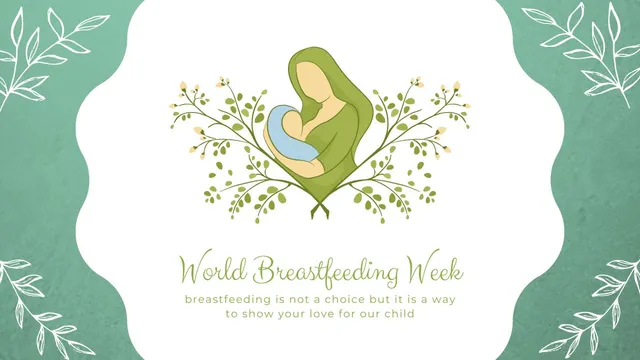- By Priyanka Munshi
- Wed, 07 Aug 2024 04:42 PM (IST)
- Source:JND
World Breastfeeding Week 2024: Understanding the benefits of breastfeeding can significantly impact a mother's and child's health and well-being, particularly in reducing the risk of breast cancer. Breastfeeding has been shown to lower the risk of breast cancer in both premenopausal and postmenopausal women. By delaying the return of a woman's menstrual cycle, breastfeeding reduces lifetime exposure to hormones such as estrogen, which are known to stimulate the growth of breast cancer cells.
Additionally, breastfeeding physically clears the breast ducts of potentially cancer-causing cells. The risk reduction is even higher for mothers who breastfeed for a cumulative period of one year or more. The more a woman breastfeeds, the more the protective effect. Breastfeeding also promotes healthy body weight and lifestyle choices, which are crucial components in cancer prevention.
Breastfeeding is essentially a natural defense against breast cancer, making it important to raise awareness about its health benefits. In a conversation with Jagran English, Dr. Mrunal Parab, a surgical oncologist at TGH-Onco Life Cancer Centre, discussed why breastfeeding is known to reduce the chances of breast cancer in women.
Extended breastfeeding benefits both the mother and the baby. It is crucial to address any doubts younger women may have about breastfeeding and encourage them to start right away. According to Dr. Mrunal, cancer involves an aggregation of cells that grow uncontrollably. Breast cancer is a disease arising in the breast where breast cells grow out of control rapidly. It can occur anywhere in the breast, usually starting in the inner lining of milk ducts or the lobules that produce milk. From there, it can spread to other parts of the breast or body. Breast cancer is further divided into early breast cancer, advanced breast cancer, and metastatic breast cancer. Breast cancer is the most common cancer among women, and its incidence is increasing among younger patients. By 2030, it is expected that one in 29 females in India will develop breast cancer. However, the five-year survival rate for breast cancer in Indian women is not even 60%.
What Are The Symptoms Of Breast Cancer?
Symptoms of breast cancer include a hard, painless lump in the breast, bloody or clear nipple discharge, nipple retraction, scaling and itching of the nipple, red inflamed breast with or without a lump, and a lump in the axilla on the same side.
What Are The Risk Factors If In Breast Cancer?
Multiple risk factors lead to breast cancer development, such as obesity, early onset of menstruation, late menopause, late age at first pregnancy, nulliparity (having no children), hormone replacement therapy for menopause, prior radiation therapy, family history of breast or ovarian cancer, and absence of breastfeeding.
How To Diagnose Breast Cancer?
For diagnosis, breast self-examination every month and awareness of the presenting features of breast cancer should be taught to all women by healthcare workers, gynecologists, and general physicians.
Also Read: 5 Remarkable Mental Health Benefits Of Journaling Daily for 30 Minutes
Dr. Mrunal emphasised that breastfeeding is an ally in the battle against breast cancer. Extended breastfeeding encourages the maturation of milk-producing cells during pregnancy and lactation, and eliminates damaged cells prone to mutation before they turn into tumors. Women who breastfeed tend to maintain a well-balanced lifestyle, including a nutritious diet and physical activity. With the rise in young breast cancer patients, conceiving a child post-treatment can be challenging.
What Are The Treatments For Breast Cancer?
Treatment of breast cancer involves surgery, chemotherapy, and radiation therapy, with no one step being excluded. Younger patients often prefer breast-conserving surgery, which maintains the size and shape of the breast. Surgery is the treatment of choice to completely remove tumors in early breast cancer and is performed before chemoradiation. Advanced and some metastatic breast cancers may require prior chemotherapy with or without targeted therapy. Breast-conserving surgery involves removing tumors and some normal tissue around them, saving most of the breast. It has been the gold standard for early breast cancer since 1990. Breast reconstruction is possible at the same time as tumor removal surgery and provides excellent results.
Dr. Mrunal added that chemotherapy in breast cancer is based on multiple factors in the final histopathology. It is administered on a 2-3 weekly basis and continues for 3-4 months. Radiation treatment begins 2-3 weeks post-chemotherapy and continues for 3-4 weeks. Younger patients can conceive after breast cancer treatment.
Breast-conserving surgery, such as a lumpectomy, can impact breastfeeding, but it doesn’t necessarily mean you can’t breastfeed at all. Here are some key points to consider:
- Milk Production: After a lumpectomy, the affected breast may produce less milk due to the removal of tissue and potential disruption of milk ducts and nerves. However, the unaffected breast can often compensate and produce enough milk to feed your baby.
- Radiation Therapy: If you’ve had radiation therapy, it can further affect milk production and the elasticity of the skin, making latching more challenging. It’s often recommended to focus on breastfeeding from the unaffected breast.
- Consultation And Support: It’s crucial to discuss your breastfeeding goals with your healthcare team early on. A lactation consultant can provide personalized advice and support to help you navigate breastfeeding after breast-conserving surgery.
- Cancer Risk Reduction: Breastfeeding itself has been shown to reduce the risk of breast and ovarian cancer. The longer you can breastfeed, the greater the benefit.

